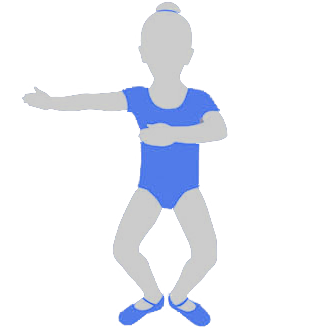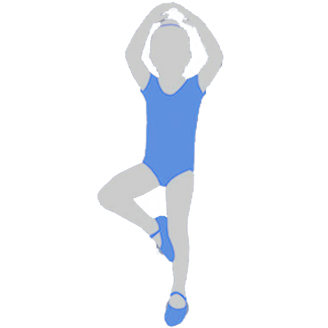We’re in it together! The staff and faculty of Dance Innovations Dance Center want to ensure that your dancer’s first dance class experience is a magical one! So we created this “Parent’s Primer” for you, the parents! TOGETHER — WE can make sure your dancer’s first class is the BEST CLASS EVER!
For the Parents...
As a parent, you provide dance education for your child hoping to give them an experience which will enrich their lives on several levels…
- You want your child to develop coordination and grace.
- You want your child to stimulate his/her creative side and to develop self-expression.
- You want your child to build their self-esteem and confidence and to feel at home in his/her body.
- You want your child to develop a lifelong appreciation for music, dance and the arts.
- And most important, you want your child to have fun!!!
…and the goal of our classes is to provide you with all of that and more!
We believe an important facet of dance education is teaching the parents about dance as well, so they can make appropriate choices for their child’s training. Information regarding proper dress, the care and fit of dance shoes, the unique differences between types of dance, is how to get the most out of classes and class options.
BEFORE the first day of dance class… what you, as a parent, can do to help:
- Please inform us of any medical, emotional or behavioral conditions/difficulties we should be aware of in order to best serve your child.
- Make sure your child has the right equipment for class: hair ties, shoes, proper attire, etc. If it is a tap class, the child will need tap shoes. Ditto for ballet. Each class has it’s own specific requirement, please refer to the DIDC Dress Code.
Dance shoes must fit well – ask your child’s teacher to check the fit of your child’s shoes, and consider what your child will be wearing inside their shoes. “Ballet slippers” that are really bedroom slippers can slide right off a dancer’s foot and cause them to trip and fall. Too-big tap shoes can fly off of feet. Even with a perfect fit, the way dance shoes are tied or fastened can make a difference – please ask your child’s teacher for recommendations or preferences. - PUT YOUR DANCER’S NAME ON EVERYTHING! …especially inside shoes and layered-attire which may be removed during dance class. Shoes can easily get swapped or placed in the wrong bag when a whole class is wearing “size 11 pink, ballet slippers”!
- Put all of your child’s dance “equipment” into a special “dance bag” so you can grab-and-go on dance class days without forgetting anything!
DANCE CLASS DAY… what you, as a parent, can do to help:
- Don’t forget your dance bag!
- Please be on time for class. Young children are particularly sensitive to entering when class has already started. They will have missed something, and they know it.
- Take your child to the bathroom before class. Please note that this is different from asking whether your child has to go to the bathroom before class. Make a trip to the bathroom part of your pre-dance-class ritual. (Once one dancer needs to be excused, suddenly every other dancer jumps on the “Potty Train”!)
- Let your instructor take care of the class in order to allow for uninterrupted creative time. For all dancers there is a time to perform and a time to be absorbed, learning about the body through the pleasure and freedom of movement for movement’s sake. Classes are closed to visitors, and parents are asked to wait outside the classroom so that dancers are free to take risks with movement, to focus in their feelings and to perform for themselves, not for others. Concentration, focus, and understanding come easier to students when the class can proceed without interruption. We make every class focused by closing out the outside world to make dance the center of attention.
- Try to maintain attendance. This promotes growth in skills, social interaction and commitment. A dancer’s attendance is vital – for themselves, their teacher, and their classmates.
A Note on Separation Anxiety…
Dance class may be the first time your child is separated from you. New places and people can be frightening at first. Until your child becomes comfortable in the class, he/she may take the first few classes to watch or
participate minimally. Some children may take several weeks to settle in and fully engage. Though your child may feel safer with you in the room, remember that other children may be shy in your presence. It is best for you to wait outside the dance studio while class is in session and watch on our closed-circuit television.
If your child is feeling uncertain or refuses to participate, here are some things you can do to help:
- Come early to look quietly around the school and transition into the studio.
- No need to sneak away, even when there are tears. Your positive enthusiasm and confident goodbye are reassuring.
- Show your dancer where you will be waiting for him/her. And that you’ll be watching your dancer on the television!
- Set a time for hugs, smiles, and kisses before and after class.
- Encourage your child to teach YOU after taking class.
- Let your child tell you what will make class feel safer – a teddy to stand in for you, or a special outfit to make her feel stronger, for example.
As important as you are to the development and learning of your dancer, as he/she grows your child also benefits from this time apart from you. Your son or daughter gains confidence in his ability to make choices, learn new
things, form ideas all on his own, and then proudly share them. As you witness these developments, enjoy! Watch as they learn to appreciate dancing with and without you. And value this dance of independence.
OUR Part...
We want every child’s introduction to dance to be a positive one, and this means respecting each student’s independent styles. Some children learn by watching, and others will joyfully jump in to try something new. Whatever your child’s learning style, we will work to make him or her comfortable with initiating this new activity. We believe in giving the child time to learn the beauty and impact of dance. After developing an appreciation and sincere love for the art, it is easy to teach children discipline and technique. From the first moment a dancer steps into the studio, we teach them to honor and respect dance. Proper dance class etiquette is observed and respect for others is encouraged. Listening and following directions is the first step towards learning.
What WE promise to do…
- To always put the dancer BEFORE the dance: Often a child needs to know what is expected of him or her or they may need time to adjust to a new space or teacher, so he or she will feel safe and comfortable. We never focus or push a child to dance because a great dance experience is born of an individual’s desire to participate. Select repetition of exercises, a familiar class format and careful explanations will eventually make joining the fun easy for every child. If your child needs time to just watch when new exercises are introduced, don’t be alarmed. He or she is still learning, just taking their time, and deciding how they feel about the experience. We do not pressure performance. When it’s the child’s idea to dance, it will come from the heart.
- To use age-appropriate music & movement: All Music in your classes is preselected to ensure that every song is age-appropriate and inspirational for the children enrolled. Music awareness is encouraged as your child is introduced to a variety of music from classical, upbeat instruments, reggae, to jazz, Broadway tunes and pop. Of course, children’s favorites like Disney songs and other popular children’s artist are used as well to make every class an adventure.
- To uphold the standards of the Youth Protection Advocates in Dance (Y.P.A.D.): As a Y.P.A.D. Certified Dance Studio, not only are DIDC classes, music, choreography, and costume dance attire in line with the guidelines set forth by Y.P.A.D., but faculty and staff are also trained in emotional health, physical safety, psychology of injury, and healthy relationships to food for dancers. They are committed to age-appropriate artistic choices and are positive role models in body image, behavior, and social media. Additionally, all DIDC faculty and staff members are background checked, CPR certified, and are trained and mandated reporters.
We look forward to meeting and working with you and your dancer very soon!
If you have any questions, please contact the studio office – (603) 436-2300
Thank you,
Miss Katie & DIDC Staff



